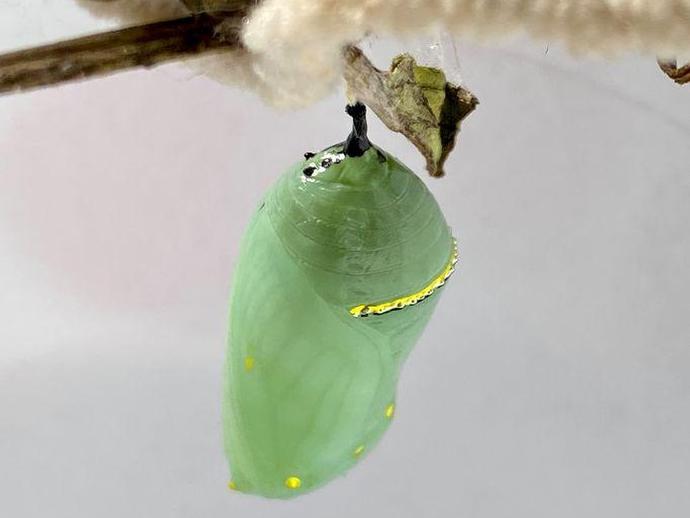September 28, 2021
Ben here with the Tuesday edition of #BenInNature presented by our friends at Carter Bank & Trust!
The other day, VMNH Trades Technician Joe Dillon showed me a monarch butterfly (Danaus plexippus) chrysalis that he's keeping safe until the butterfly emerges!
First things first: what exactly is a chrysalis? It's definitely not the same thing as a cocoon! A cocoon is a covering, usually made of silk, that some insects build around themselves to protect them as they grow. A chrysalis, on the other hand, is a pupa; when you see a monarch butterfly chrysalis, you're not looking at a protective shell, you're looking at the butterfly itself, just in a different stage of life!
To transform into a chrysalis, a monarch butterfly caterpillar finds a safe spot and then spins a little silk pad on a downward-facing surface. Next, the caterpillar latches onto the pad with its last pair of hind legs and hangs upside down in the shape of the letter J. After 12-16 hours, the caterpillar will straighten out and begin contracting and relaxing, at which point its skin will split right behind its head. Over the next several minutes, the caterpillar will shed its skin, revealing the green chrysalis. The chrysalis is initially long and soft, but over the next few hours it will shrink into the same small, distinctive shape as the chrysalis in the photo.
Depending on the temperatures, it takes just a week or two for the butterfly to shed the chrysalis. You can actually tell how close the butterfly is to emerging based on the color of the chrysalis; a day or so from emergence, the chrysalis will be bluish in color, and within about 12 hours or emergence, the chrysalis will turn transparent, revealing the black and orange coloration of the butterfly within.
Unfortunately, monarch butterflies have a very high mortality rate, and they sometimes choose to pupate in inconvenient and dangerous locations. If you find yourself needing to move a monarch chrysalis to a safer spot, check the following link for more info: https://www.saveourmonarchs.org/blog/how-to-move-a-monarch-chrysalis
ABOUT #BenInNature
Social distancing can be difficult, but it presents a great opportunity to become reacquainted with nature. In this series of posts, Administrator of Science Ben Williams ventures outdoors to record a snapshot of the unique sights that can be found in the natural world. New updates are posted Monday - Friday, with previous posts highlighted on the weekends. This series of posts is made possible thanks to the support of VMNH Corporate Partner Carter Bank & Trust (www.cbtcares.com).
NATURE PHOTO IDENTIFICATIONS
If you discover something in nature that you would like help identifying, be sure to message us right here on Facebook with a picture (please include location and date of picture) and we'll have our experts help you identify it!

 Hours & Admissions
Hours & Admissions Directions
Directions

